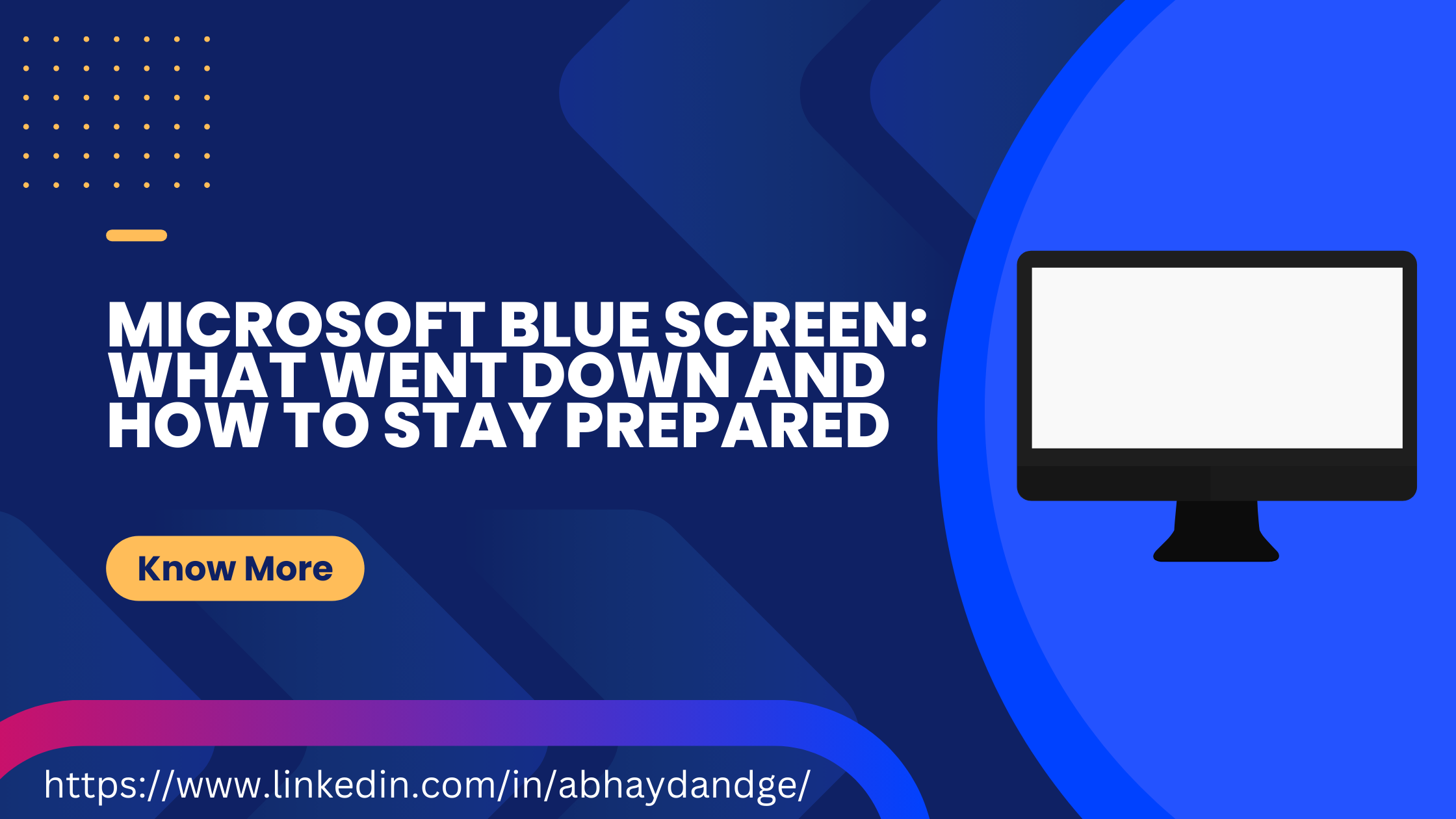Yesterday’s Microsoft Blue Screen: What Went Down and How to Stay Prepared
 Abhay Dandge
Abhay Dandge
Hey tech enthusiasts! 🌟 Did you experience yesterday’s Microsoft Blue Screen event? If so, you weren’t alone. It’s been the talk of the tech world, causing quite a stir. Let’s dive into what happened, why it happened, and how you can stay prepared for such events.
The Incident: What Happened?
On July 19th, 2024, many Windows users experienced the notorious Blue Screen of Death (BSOD). This unexpected system crash left users staring at the dreaded blue screen with cryptic error codes, disrupting their work and causing widespread frustration.
The Cause: Decoding the Blue Screen
The root cause of the BSOD incident was traced back to a recent Windows update. The update, which aimed to patch security vulnerabilities and enhance system performance, inadvertently introduced a conflict with certain hardware drivers. This conflict caused systems to crash unexpectedly, leading to the blue screen error.
Microsoft’s Response
Microsoft’s response was swift. Acknowledging the widespread issue, they promptly rolled out a fix to address the problematic update. Users were advised to check for updates and install the latest patches to resolve the issue.
How to Stay Prepared for Future Blue Screen Events
While BSODs are rare, they can be disruptive. Here are some tips to help you stay prepared and minimize downtime:
1. Regular Backups
Ensure you have regular backups of your important data. Use tools like Windows Backup, OneDrive, or third-party backup solutions to keep your files safe. Regular backups ensure you can quickly recover your data in case of a system crash.
2. Stay Updated, but Be Cautious
Always keep your system updated to benefit from the latest security patches and features. However, consider delaying updates by a few days to see if any widespread issues are reported. This gives you time to avoid potentially problematic updates.
3. Create a System Restore Point
Before installing any major updates, create a system restore point. This allows you to roll back your system to a previous state if something goes wrong.
How to Create a Restore Point:
Open the Start menu and search for "Create a restore point."
Select your system drive (usually C:) and click "Create."
Name your restore point and click "Create."
4. Check Hardware Compatibility
Ensure your hardware drivers are up-to-date and compatible with the latest Windows updates. Visit your hardware manufacturer’s website for the latest drivers and updates.
5. Use Safe Mode for Troubleshooting
If you encounter a BSOD, boot your system in Safe Mode. This minimalistic mode loads only essential drivers, allowing you to troubleshoot and fix the issue.
How to Boot in Safe Mode:
Restart your computer.
Press F8 before the Windows logo appears.
Select "Safe Mode" from the advanced boot options menu.
Fun Yet Professional Takeaway
Blue Screens of Death are like unexpected rain showers – they’re rare but can disrupt your day. Being prepared with regular backups, cautious updates, and troubleshooting know-how ensures you stay dry even when the storm hits.
Ending with a Splash
Did yesterday’s blue screen catch you off guard? 🌧️ Share your experience and how you handled it! For more tips on navigating tech hiccups, follow me on LinkedIn and Twitter. Let’s make tech troubleshooting simpler, one tip at a time!
Hashtags
#Microsoft #BlueScreen #BSOD #TechTips #WindowsUpdate #Troubleshooting #TechLife #Productivity
Subscribe to my newsletter
Read articles from Abhay Dandge directly inside your inbox. Subscribe to the newsletter, and don't miss out.
Written by

Abhay Dandge
Abhay Dandge
Hello, I'm Abhay, a DevOps Engineer passionate about optimizing operations through automation, continuous integration, and deployment. Over the past year, I've sharpened my skills in the fast-paced world of DevOps and Cloud Computing. My journey has been defined by hands-on experience and a commitment to exploring the latest technologies. ╭━━━╮╱╱╱╱╱╭━━━╮ ╰╮╭╮┃╱╱╱╱╱┃╭━╮┃ ╱┃┃┃┣━━┳╮╭┫┃╱┃┣━━┳━━╮ ╱┃┃┃┃┃━┫╰╯┃┃╱┃┃╭╮┃━━┫ ╭╯╰╯┃┃━╋╮╭┫╰━╯┃╰╯┣━━┃ ╰━━━┻━━╯╰╯╰━━━┫╭━┻━━╯ ╱╱╱╱╱╱╱╱╱╱╱╱╱╱┃┃ ╱╱╱╱╱╱╱╱╱╱╱╱╱╱╰╯⠀⠀⠀⠀⠀⠀⠀⠀⠀⠀⠀⠀⠀⠀⠀⠀⠀⠀⠀⠀⠀⠀⠀ In my tech toolkit, I’ve got the skills to make things run smoother: containerization, cloud platforms, and flawless CI/CD pipelines. My goal? To supercharge software delivery for organizations, making it faster and more efficient, all while keeping things top-notch and rock-solid. Let’s keep it cool and reliable! 🅃🄴🄲🄷 🅂🅃🄰🄲🄺 🔲 Cᴏɴᴛᴀɪɴᴇʀɪᴢᴀᴛɪᴏɴ -: Dᴏᴄᴋᴇʀ | Pᴏᴅᴍᴀɴ | Bᴜɪʟᴅᴀʜ | CᴏɴᴛᴀɪɴᴇʀD 🔲 Cᴏɴᴛᴀɪɴᴇʀ Oʀᴄʜᴇsᴛʀᴀᴛɪᴏɴ -: Kᴜʙᴇʀɴᴇᴛᴇs | Dᴏᴄᴋᴇʀ Sᴡᴀʀᴍ 🔲 Cʟᴏᴜᴅ Pʟᴀᴛғᴏʀᴍs -: AWS 🔲 Aᴜᴛᴏᴍᴀᴛɪᴏɴ ᴀɴᴅ Sᴄʀɪᴘᴛɪɴɢ-: Bᴀsʜ, Pʏᴛʜᴏɴ * Linux Administration (RHCSA) 🔴 * DevOps methodologies. * CLA (Certified Linux Admin) * CCA (Certified Container Admin) -̶-̶-̶-̶-̶-̶-̶-̶-̶-̶-̶-̶-̶-̶-̶-̶-̶-̶-̶-̶-̶-̶-̶-̶-̶-̶-̶-̶-̶-̶-̶-̶-̶-̶-̶-̶-̶-̶-̶-̶-̶-̶-̶-̶-̶-̶-̶-̶-̶-̶-̶-̶-̶-̶-̶-̶-̶-̶-̶-̶-̶-̶-̶-̶-̶-̶-̶-̶-̶-̶-̶-̶-̶-̶-̶-̶-̶-̶-̶-̶-̶-̶-̶-̶-̶-̶-̶-̶-̶-̶-̶-̶-̶-̶-̶-̶-̶-̶-̶-̶-̶-̶- How can I help you? I can help you with the optimization and scalability of your infrastructure with my expertise in Linux, Containers, AWS, and orchestration. From streamlining deployments with Docker and Kubernetes to maximizing cloud efficiency, I'll ensure your systems are robust and scalable. Let's tackle your challenges and take your projects to the next level. Let's connect and discuss how we can collaborate! :) -̶-̶-̶-̶-̶-̶-̶-̶-̶-̶-̶-̶-̶-̶-̶-̶-̶-̶-̶-̶-̶-̶-̶-̶-̶-̶-̶-̶-̶-̶-̶-̶-̶-̶-̶-̶-̶-̶-̶-̶-̶-̶-̶-̶-̶-̶-̶-̶-̶-̶-̶-̶-̶-̶-̶-̶-̶-̶-̶-̶-̶-̶-̶-̶-̶-̶-̶-̶-̶-̶-̶-̶-̶-̶-̶-̶-̶-̶-̶-̶-̶-̶-̶-̶-̶-̶-̶-̶-̶-̶-̶-̶-̶-̶-̶-̶-̶-̶-̶-̶-̶-̶-̶-̶-̶-̶-̶-̶-̶-̶-̶-̶-̶-̶- ………………………………………………………………… #devops #devsecops #sre